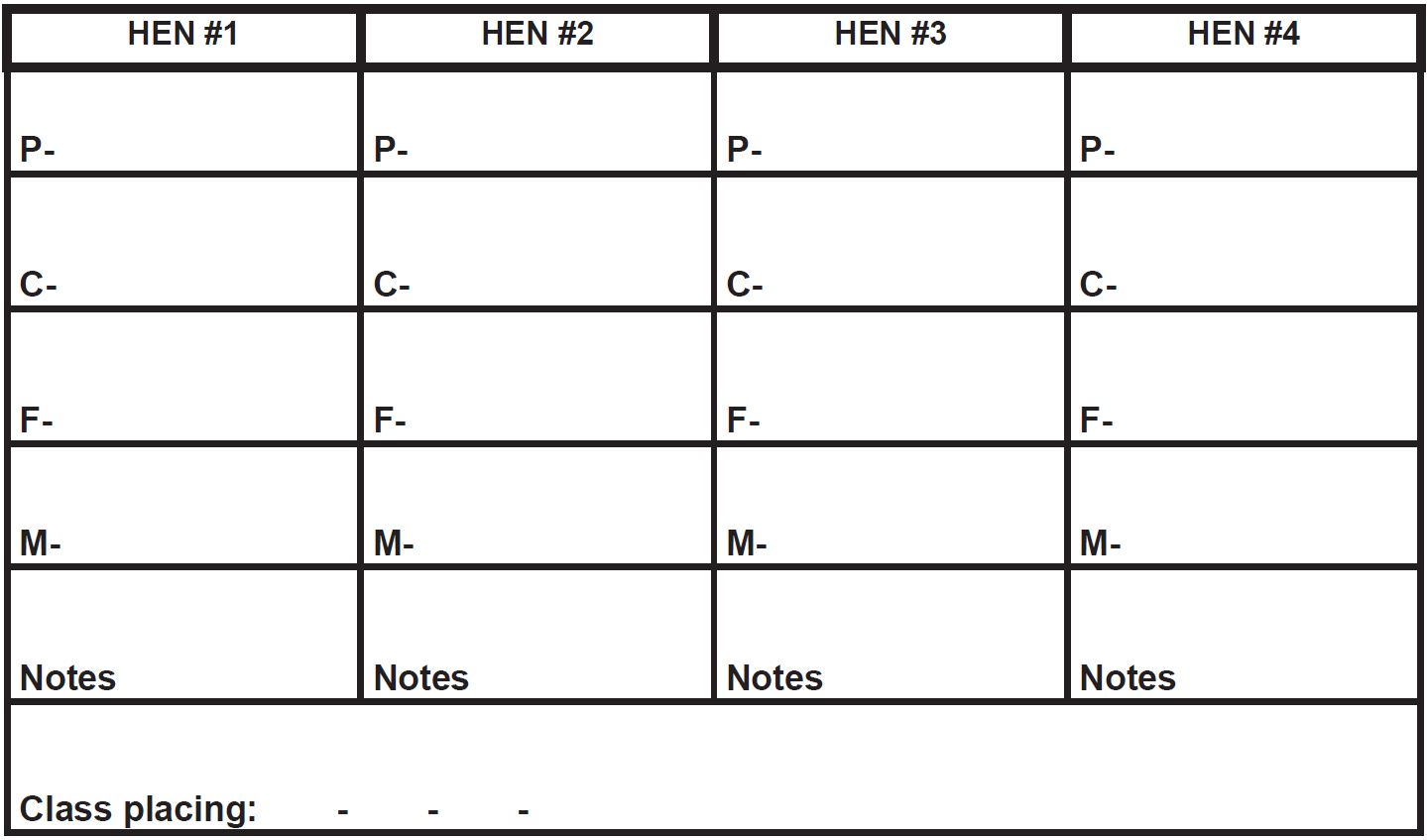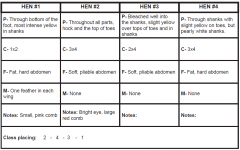Past Egg Production Evaluation and Oral Reasons
In past production hen classes, four live laying hens are judged and ranked according to factors that help determine the number of eggs they have laid prior to the contest. The laying hens are judged on PAST PRODUCTION and CURRENT PRODUCTION factors. These judging factors are based on scientific principles and observations. These principles are still used today to cull poor producing hens from flocks.
The past production factor of PIGMENT LOSS is the best indicator of the number of eggs each hen has laid. This signifies which hen has had the longest period(s) of continuous egg production.
Current production factors indicate the hen's current rate of egg production which is determined by the traits of ABDOMINAL CAPACITY, ABDOMINAL FAT CONDITION, and MOLT.
Health and vigor are indicated by the shape and brightness of the eye, the proportional shape of the head, and the condition of the comb and wattles. Health and vigor are NOT used in placing the hens but are suggested as describing factors when giving reasons.
When judging the class of production laying hens there is a very specific order of importance of these factors when placing the class.
The specific order of importance for factors when placing hens are:
- Pigment Loss
- Abdominal Capacity
- Abdominal Fat Condition
- Molt
The specifics for evaluating each factor will be discussed in future sections, but it is important to remember that pigment loss is always the first and most important characteristic that should be used to place the class. The hen that has bleached (lost pigment) and has the whitest shanks should always be placed first. If two hens have the same pigment loss, use the abdominal capacity to split that pair. The hen with a better abdominal capacity is placed above one with poorer abdominal capacity but only if they have the same level of pigment loss. If, in your judgment, two hens have equal pigmentation and have the same abdominal capacity, then place the hen with the least abdominal fat condition above the hen with the heavier abdominal fat condition. Finally, if you consider the top three factors (pigment loss, abdominal capacity, and abdominal fat condition) to be equal between two hens, split the placing of the two hens based on their molt condition. When all other factors are the same, the hen showing no current molt should be placed above one that shows active molt in the primary wing feathers.
This manual will guide you on how to handle and judge a hen, how to check for and describe factors previously mentioned, how to place the past production hen class, and then how to present oral reasons to defend your placing.
When judging past production hens and giving oral reasons, it is important to be familiar with the parts and anatomy of the hen as well as the proper terminology to describe what you are observing.
Figure 1 shows the parts of a White Leghorn hen important in production judging. The pubic bones are found on either side of the vent. The abdomen is located between the pubic bones and the tip of the keel (breast bone).
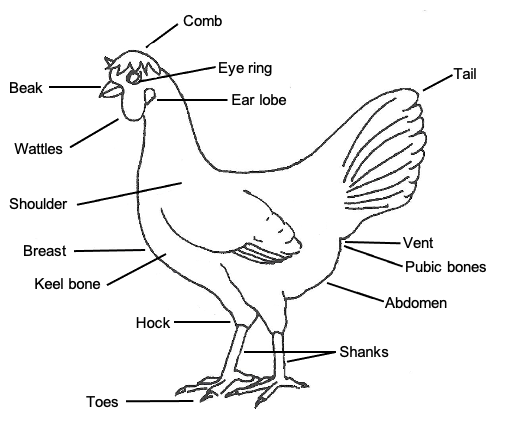
1. PIGMENT LOSS/ BLEACHING
The most important factor in determining past egg production is the loss of pigment from the skin and shanks of the hen. This is referred to as bleaching. These standards apply to any breed that has yellow-pigmented skin and shanks. In the national contest, Leghorn hybrids are used for egg production classes since they have yellow pigment in their skin and shanks. They are also a common breed and easy to find. For practice, other breeds having yellow-pigmented skin and shanks can be used if Leghorns are not available. Examples are production sex-linked reds, or American class breeds like Plymouth Rocks, Rhode Island Reds, or New Hampshire Reds which are commonly raised in small flocks.
The yellow pigment is deposited in the skin, beak, shanks, and feet while the chicken is a growing pullet. At sexual maturity, which occurs at 17-20 weeks of age, the pullet starts to lay eggs. The pigment then bleaches from the pigmented areas in a definite order according to the approximate number of eggs the hen has laid. By knowing the order of pigment loss or bleaching, you can easily rank the hens for past egg production. Learning the order of pigment loss is critical prior to judging any hen classes.
Pigmentation loss occurs in the following order:
- Vent
- Eye ring
- Ear lobe
- Beak (corner of the mouth toward the tip)
- Bottom of the foot
- Pigment loss over the entire shank (front, back, and sides)
- Hock and top of the toes
Hens can regain their pigment when they go into a molt and stop egg production. The pigment returns to the skin in the same order it is bleached: vent, eye ring, ear lobe, beak, the bottom of the foot, entire shank, hock, and top of the toes. Hens that show signs of regaining their pigment tend to be poor producers.
2. ABDOMINAL CAPACITY
Abdominal capacity refers to the size of the laying hen’s abdominal area. The larger the abdominal capacity, the better the current level of production. The abdominal spread is a term used to refer to the measurement associated with the width and depth of the abdomen. Abdominal capacity is usually measured by comparing the number of fingers you can get 1) between the pubic bones and 2) between the pubic bones and the tip of the keel. The first number in the spread refers to the width between the pubic bones and the second number refers to the depth of the abdomen. For example, if you can fit two fingers in between the pubic bones, and three fingers for the depth of the abdomen, then you would refer to the spread as 2 x 3.
3. ABDOMINAL FAT CONDITION
A hen uses the energy in the feed she eats to produce eggs. If she is not laying eggs, she does not require as much dietary energy and much of the energy from the feed she eats is deposited as fat. The amount of fat in the abdomen, therefore, is a good indicator of the hen’s level of production. Abdominal fat condition refers to the fat content in the abdominal area. The fat in the abdominal area is referred to as the abdominal fat pad.
4. MOLT
Molt is another factor used to evaluate hens' current production. Molt is the loss of primary feathers that occurs when a hen stops producing eggs. Molt is evaluated by counting the number of primary wing feathers. In a non-molted hen, there are 10 primary feathers that are separated from the secondary feathers by a single, smaller feather known as the axial feather. If there are primary feathers missing, or if new primary feathers are growing in to replace lost feathers, that indicates that the hen is in a molt.
The main concept to understand about molt is that feather growth and egg production both require a large amount of protein. A hen cannot be replacing long feathers (molting) and lay eggs at the same time. So, when a hen is molting it is most likely not in production.
REMOVING HENS FROM THE CAGE
When evaluating live animals, the welfare of animals is important and should be considered. Being well-trained in handling hens is important to prevent discomfort or harm to them. In order to maintain the welfare of the hens, the following procedure should be adhered to. Approach the cage slowly, open the door quietly, and prepare to remove the hen from the cage, headfirst. To remove the hen easily and properly, maneuver it until it stands with its head facing you. Place your hand above the hen and quickly, but gently, pin her to the floor of the cage. With both hands, hold the wings next to the body; lift the hen slightly off the floor, and turn her to face the cage door. Then slide your non-dominant hand, palm up along the hen’s keel or breastbone, place your thumb on the outside of one leg, your index finger between the hen’s legs, and the rest of your fingers to the outside of the second leg. Hold the legs gently but firmly at the hocks and lift the hen off the floor of the cage. Steady her with your free hand. Hold the legs gently but firmly above the hocks. Put your index finger between the hocks, your thumb around one leg, and your remaining fingers around the other leg. Carry the weight of the hen with the hen’s breast in the palm of your hand. Then bring the bird out of the cage, headfirst, keeping its head toward you. It is recommended that you practice moving the bird from one hand to the other to allow you to use both hands when opening the wings. Also, holding the birds in your non-dominate hand allows your dominant hand to be available to take written notes. While resting the hen's body on the palm of your hand you can open both wings and check for a molt.
Placing the hen’s head between your body and arm will help to control it. One hand is then free to examine the hen and take notes. If you are right-handed it is best to hold the hen with your left hand so that your writing hand is free to take notes. If you are left-handed, hold the hen with your right hand. Never hold a laying hen upside down by their legs or allow them to flap their wings. Always return the hen to the coop headfirst and lower the hen gently to the floor of the coop before releasing her. You are only allowed to handle one hen at a time and cannot compare your hen with a different hen that someone else is handling. NEVER HANDLE OR COMPARE TWO HENS AT ONE TIME.
To examine the hen, hold her back against your stomach, with her head slightly downward. From this position, you can see the vent and check for pigment loss, abdominal capacity, and abdominal fat condition.
Demonstration video (YouTube link)
GETTING STARTED
First, prepare to take notes on each hen as you study her production characteristics. An example of a notetaking table is shown below (click on image to enlarge).
- P = PIGMENT loss
- C = Abdominal CAPACITY
- F = Abdominal FAT condition
- M = MOLT
The NOTES area is for anything else you see as important to note in your oral reasons like indicators of health and vigor
An example of notetaking is shown below (Click on image to enlarge):
BEFORE HANDLING HENS IN A CLASS
To begin, stand back for 30 seconds and look at all four hens in the class (see Figure 2). Take notes of obvious pigment loss. If you can choose a top and bottom hen, make note of that observation. The top hen should have a beak and shanks that are well bleached. This will be the best egg producer in the class. Poor layers may have some pigment in the beak or shanks. They may also have dull, shrunken combs and wattles. Remember that the hen with the most pigmentation loss has laid the most eggs, regardless of her current production factors or state of health.
After seeing the class from a distance, remove each hen from the cage and make notes of your observations. Remove and observe only one hen from a cage at a time. Remember that in this contest the hens will be handled by many contestants so all effort must be taken to handle them gently. In the contest, you can only handle one hen at a time, and you must return her to the cage you took her out of before removing another hen from its cage. Do not pass hens from one person to another during the contest.
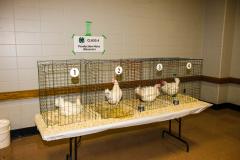
EXAMINING HENS FOR PIGMENT LOSS
Lift the hen in front of you. Hold her in the palm of your hand. Your free hand should gently hold the neck and head. Look for pigment loss from the eye ring, ear lobe, and beak (Figure 3).

To examine the hen further, hold her back against your stomach, with her head slightly downward. From this position, you can check the hen for pigment loss in the vent, back of the shank, and the bottom of the foot (see Figure 4). You can also look at the shanks and top of the toes (see Figure 5). They should be bleached through the hocks and top of the toes. Record your observations in your notes.
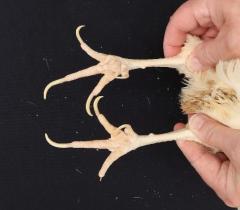
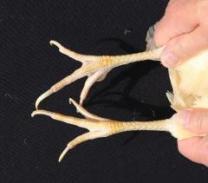
You have now looked for bleaching from the vent, eye ring, ear lobe, beak, the bottom of the foot, entire shank, hock, and top of the toes. Record the last area that has bleached. In other words, select the part of the hen that seems to be the last part that shows color. If a hen has a white beak, white skin at the bottom of the foot but shows a good bit of yellow in the shank, that hen should be noted as bleached through the bottoms of the feet. After you observe all the hens you may wish to add more specific notes about the level of pigment (yellow) in the shank or other areas.
One area of confusion is the few heavy scales at the base of the shank that do not shed as quickly as the other scales. It is not uncommon for a hen that looks totally bleached in the shanks to have a few bright yellow scales at the base of the shank. It is important to consider the overall degree of pigment in the entire shank, not just a few bright yellow scales at the base of the shank. A hen with pearly white shanks and few bright yellow scales at the base of the shank (Figure 6) should be placed over a hen with pale yellow in the shanks and scales that may not be as bright at the base of the shank (Figure 7). So, do not consider the scales at the base of the shank as the main factor unless all other parts have a similar level of bleaching.
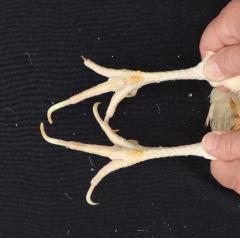
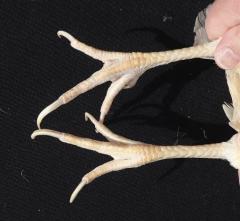
Remember to consider the pigment loss over the entire shanks (front, back, and sides) before making your notes. Pull the feathers back from the hock to see the last of the scales in this area. A few of them may have pigment.
COMPARING A GOOD AND BAD LAYER
Vent
The good producer has a bleached vent (see Figure 8). Look at its outer edges of the vent. Notice its moistness. Also, the vent is large and oblong in shape. This is the appearance of the vent of a high-performing layer. Notice the yellow pigment in the vent of the poor producer (Figure 9). It has some moistness, but the vent is small and round.
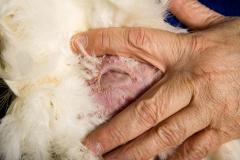
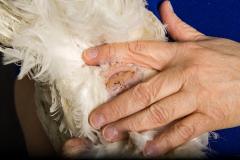
Face
There is total bleaching of the eye ring, ear lobes, and beak of the good layer (Figure 10). The comb and wattles are large, red, and glossy.
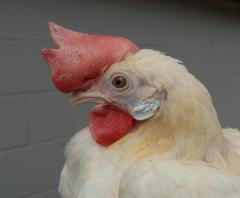
Yellow pigment is present in all parts of the poor layer's head (Figure 11). The comb is small and pale.
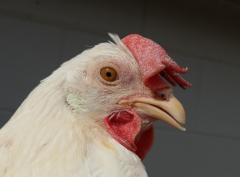
Feet
Turn the hen so you can observe the bottom of the feet and back of the shanks. Figure 12 shows the bottom of the feet and back of the shanks of a good layer. The bottom of the foot webs are pink and show a loss of yellow pigment. The back of the shank has bleached from the base of the shank to the hock. The color is in the web between the toes and next to the footpad. The footpad is often light-colored or stained from walking. There is no pigment to be seen in the area up to the hock (where fingers are holding the shank).
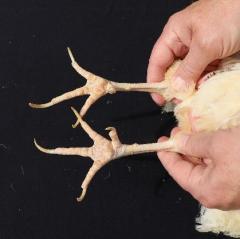
Figure 13 shows the back of the shank and bottom of the feet of a poor egg producer. There is a large amount of pigment in the bottom of the foot webs and toes. There is some yellow color at the bottom of the shank and on up to the hock.
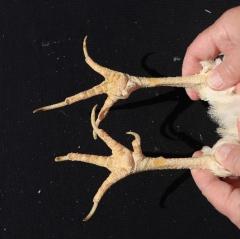
Turn the hen so you can see the front of the shank and top of the toes. Figure 14 shows the front of the shank and the top of the toes of a good egg producer. There is some yellow pigment at the base of the shank (where the shank meets the top of the toes). Some very good layers may never bleach this part of the foot. Start at the top of the shank and study the loss of pigment down the front toward the foot. The good layer has bleached this area of the shank.
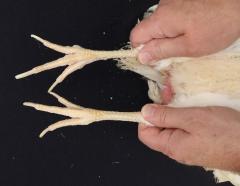
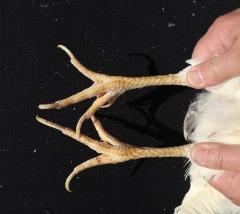
Figure 15 is an example of a poor layer. Poor layers show intense pigmentation down the front of the shank and the pigmentation extends down over the tops of the toes.
Remember to consider the pigment loss over the entire shanks (front, back, and sides) before making your placings. Pull the feathers back from the hock to see the last of the scales in this area. A few of them may have pigment. If you do not look, you may miss pigment in this area.
The good producer is bleached in the hock and tops of the toes. Yellow is present in the hock and toes of the poor layer.
Remember, your placing is based on bleaching or pigment loss from the vent, eye ring, ear lobe, beak, the bottom of the foot, entire shank, hock, and top of the toes, in that order. The more parts that are bleached, in order, the more eggs the hen has laid. Hens with identical bleaching are split on abdominal capacity. abdominal fat condition, and molt.
Remember that Pigment loss is the most important factor in placing the class.
EXAMINING THE HENS FOR ABDOMINAL CAPACITY
Next, holding the hen in the palm of your hand, tipping the hen slightly forward to examine the abdominal capacity.
1. Place your hand gently over the vent opening and place your fingers between the pubic bones (bones located on each side of the vent) to see how many fingers fit between the two pubic bones. Count the number of fingers between the pubic bones. This is abdominal width. See Figure 16 which shows a two-finger width between the public bones.
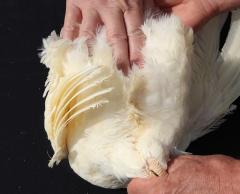
2. Then place your index finger just below the bottom of the pubic bones and place as many fingers as you can between the bottom of the pubic bones and the rear tip of the keel bone. Count the fingers to find the abdominal depth. See Figure 17 which shows a four-finger depth between the tip of the keel and the pubic bones.
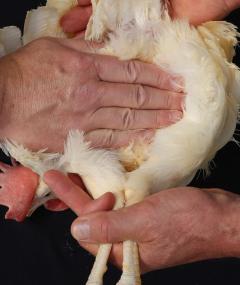
Record the number of fingers between the public bones and between the public bones and the rear tip of the keel. Always record width first and depth second for true comparisons. Record this information in your notes consistently to avoid mistakes. Depth is usually greater than width, but not always. You are using your fingers to help you make a comparison in the size of abdominal capacity among hens. DO NOT use the number of fingers when discussing hen abdominal capacity in oral reasons. The number of fingers does not matter as much as if there are differences in capacity between hens. Different people have very different finger sizes so a 2x3 capacity for one person may be a 3x5 capacity for someone with smaller hands. It is best to state that a hen has a “greater spread between the pubic bones and the keel bone” than the hens in the lower placing.
EXAMINING THE HENS FOR ABDOMINAL FAT CONDITION
While holding the hen with its back against your stomach, pinch the skin on the abdomen between the vent and the tip of the keel (Figures 18 and 19). Pinch and roll the skin gently between the thumb and finger to feel its thinness. Feel the softness or hardness of the abdomen. Softness and thinness mean a lack of fat. Hardness and thickness mean fat in the abdomen. A soft, pliable abdomen will feel like you are pinching and rolling the skin on your cheek.
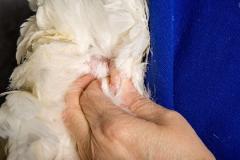

Figure 19. Hen with extra abdominal fat indicating she is a poor egg producer
A lean, trim condition of the abdomen means good current production. Record this information in your notes. Good abdominal fat condition is usually expressed as “Thin and Pliable abdomen.” Poor abdominal fat condition is usually expressed as “Hard or Fat Abdomen.”
EXAMINING THE HENS FOR MOLT
To observe molt, place the hen in the palm of one hand and pull the wing open like a fan with the other hand. The first ten long feathers closest to the wingtip are the primary feathers. The short feather in the middle is the axial feather. You can find the axial feather by running your index finger under the wing at the joint between the wingtip (metacarpus bone) and the wing flat (ulna bone) and gently pushing up. The long feathers in the wing growing between the axial feather and the hen’s body are the secondary wing feathers.
The feathers that are most important to observe are the 10 primary feathers that grow on the outside of the axial toward the wing tip. Hens molt from the axial to the tip. Old feathers that have not molted will be worn on the ends and may be broken or dirty. New or molted feathers will have smoother ends and appear clean. They also may have different lengths if the hen is currently growing in new primary feathers. The good producer will have old, worn feathers, indicating she has not molted. A poor producer will have some short new feathers just outside the axial, showing she is now in a molt. Some hens will continue to lay while molting, but usually at a much-reduced rate. This means they will have laid fewer eggs than those that have not molted. Preferably, a hen should not molt until she has completed 12-14 months of production.
Record information about any hens that are molting and how many feathers molted so you can mention this in your oral reasons. Although molt seldom helps you place your class, it may be helpful in giving a more complete set of reasons for a class.
Figure 20 illustrates what the wing feathers look like showing a normal wing with the axial feather dividing the primaries from the secondary feathers. Figure 21 is a wing with primaries 1 through 5 (counting out from the axial feather) being molted. The more primaries molted, the longer the hen has been out of production and the fewer eggs she has laid.


PLACING A CLASS AND GIVING REASONS
The following make-believe notes (click on image to enlarge) are used to demonstrate how this is done to make preparing oral reasons easier and more complete.
To place the class, first rank the hens according to their pigment loss. Look at the notes. Hen number 2 is the only hen that is completely bleached through the hock and the top of the toes. This means she shows better past production and has likely laid more eggs than hen numbers 1, 3, and 4. She is placed first. Hen number 4 is placed second because she is bleached through the shanks but has some pigment on the top of the toes. Hen number 3, which is bleached into the shanks with some pigment in shanks and toes, is placed third. Hen number 1, with yellow shanks, has bleached only to the bottom of her feet, therefore she is placed fourth. The placing is now made ranking the hens 2-4-3-1.
PREPARING ORAL REASONS
Like anything else, to become comfortable and proficient at oral reasons, you will need to practice with multiple and different classes. It is important to become comfortable giving reasons that discuss each specific class of hens you judge. Memorizing one set of reasons and using them for any class you judge is not appropriate and will be recognized by the reasons judge and will not score well. The reasons must be specific to the class you judged.
The contestants should wear business casual (professional) clothing that is comfortable and does not have anything that would identify your name, your club, or state to the judges. DO NOT wear hats or chew gum in the reasons room. Practice speaking at a confident, steady rate and at a volume that the judges can hear everything you say. Avoid long pauses, talking too fast, or speaking so loudly that it seems like you are shouting at the judges. Use proper terminology for the contest and only stress the key differences in the class. Adding a few comments that demonstrate your knowledge of the factors as they fit the class is okay if they are to the point.
A few points to avoid when preparing and giving reasons.
- Do not discuss the number of fingers between the pubic or pubic and tip of the keel. Discuss specifically where the spread is greater between two hens. The number of fingers does not matter since your fingers are of a different size than the judges.
- Do not recite the order of pigment loss for each pair.
- Do not try to tell the judges how many eggs the hen has laid or how long you think the hens have been in production.
- Do not talk about points that do not matter in the placing of the class (i.e., pretty feathers, nice personality, cleaner feet, etc).
- Have a solid understanding of the factors in judging the production hen class. Judges may ask a question to determine if you understand the specific factors in placing a class.
As you prepare your reasons, think of organizing the reasons as a short news article. Give an opening statement to catch the judges’ attention. Then give a short introduction to the main points of the first pair of hens in the placing. Then give a short paragraph discussing the details of the key differences. Do this with each pairing: 1st with 2nd place, 2nd with 3rd place, 3rd with 4th place. Mention the last place hen, any factors that were not used in the placing of your class, and finish with a closing statement.
As you read the following set of reasons, study how each note describes the class, justifies a placing, describes a hen, or compares two hens. Notice how the terms bleaching, pigment loss, past production factor, current production factors, abdominal capacity, abdominal fat condition, and molt are used.
Example of a set of oral reasons
Use the make-believe notes to prepare an example of oral reasons.
Good Morning:
I am Contestant number 10. I place this class of White Leghorn production hens 2-4-3-1. I had a definite top pair, close middle pair, and an easy bottom pair.
I place hen number 2 at the top of the class and over hen number 4 because of pigment loss and Abdominal Fat Condition.
Hen number 2 is totally bleached through the hock and the tops of the toes. This indicates that hen number 2 displays the best past production in this class. Hen number 2's abdomen is soft and pliable, while hen number 4 has a hard abdomen showing signs of fatty deposits. Both hens had a similar abdominal capacity. Both hens had red and waxy combs.
I place hen number 4 second and over hen number 3 because of pigment loss and abdominal capacity.
I found that hen number 4 has slightly less pigment on her shanks than hen number 3. Hen number 4 also had a greater spread between the pubic bones than did hen number 3. I grant that hen number 3 has a softer and more pliable abdomen than hen number 4. However, I still placed hen number 4 over hen number 3 because hen number 4 has the best past production as shown by greater bleaching.
In the easy bottom pair, I placed hen number 3 over hen number 1 because of pigment loss, abdominal capacity, and abdominal fat condition.
Hen number 3 shows pigment loss in the shanks while hen number 1 has only bleached through the bottom of the foot and shows intense pigment over the entire shank. Hen number 3 also had a better abdominal capacity with a greater spread between the pubic bones and the pubic and keel bones than hen number 1. Hen number 3 has a softer abdomen, whereas hen number 1 has a hard, fat abdomen.
I placed hen number 1 last because she lacks Past Production traits as shown by the intense pigment in her shanks. Hen number 1 also lacks current production traits, because of her small capacity and fatty abdomen.
Although molt was not a factor in the placing of this class, hen number 1 showed a one feather molt in both wings.
All the hens showed signs of good health and vigor.
For these reasons, I placed this class of White Leghorn production hens 2-4-3-1. Thank you. Are there any questions?
SUMMARY
Remember, hens ranked for past production are first placed on pigment loss, then abdominal capacity, followed by the abdominal fat condition, and, finally, molt. Pigment loss indicates the past production traits or the number of eggs laid. A large abdominal capacity goes with high egg production. Good abdominal fat condition is characterized by the hen's leanness and trimness. Signs of molt mean the hen stopped or slowed her current production and did not lay as many eggs as she should have. These four factors are the keys to judging hens for past egg production.
